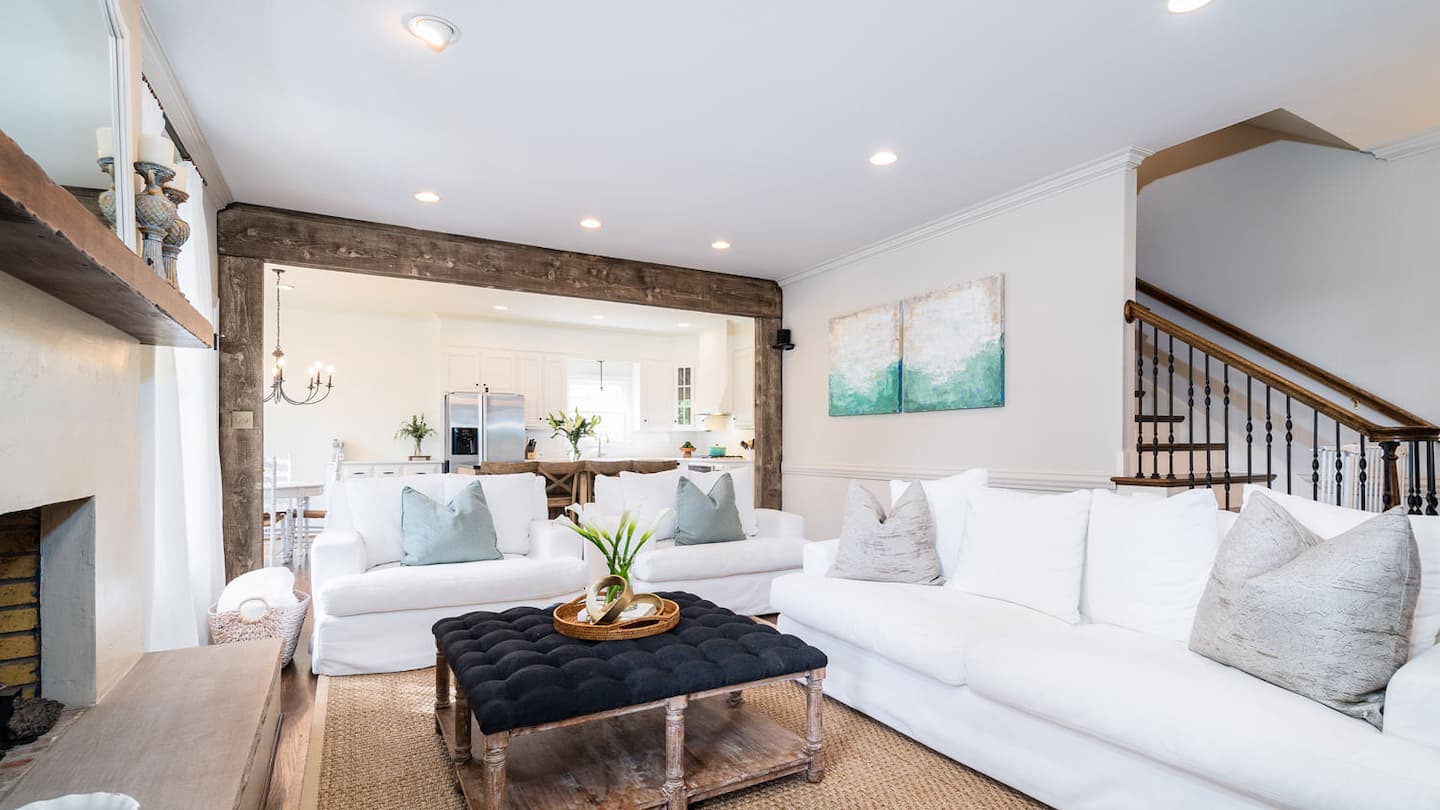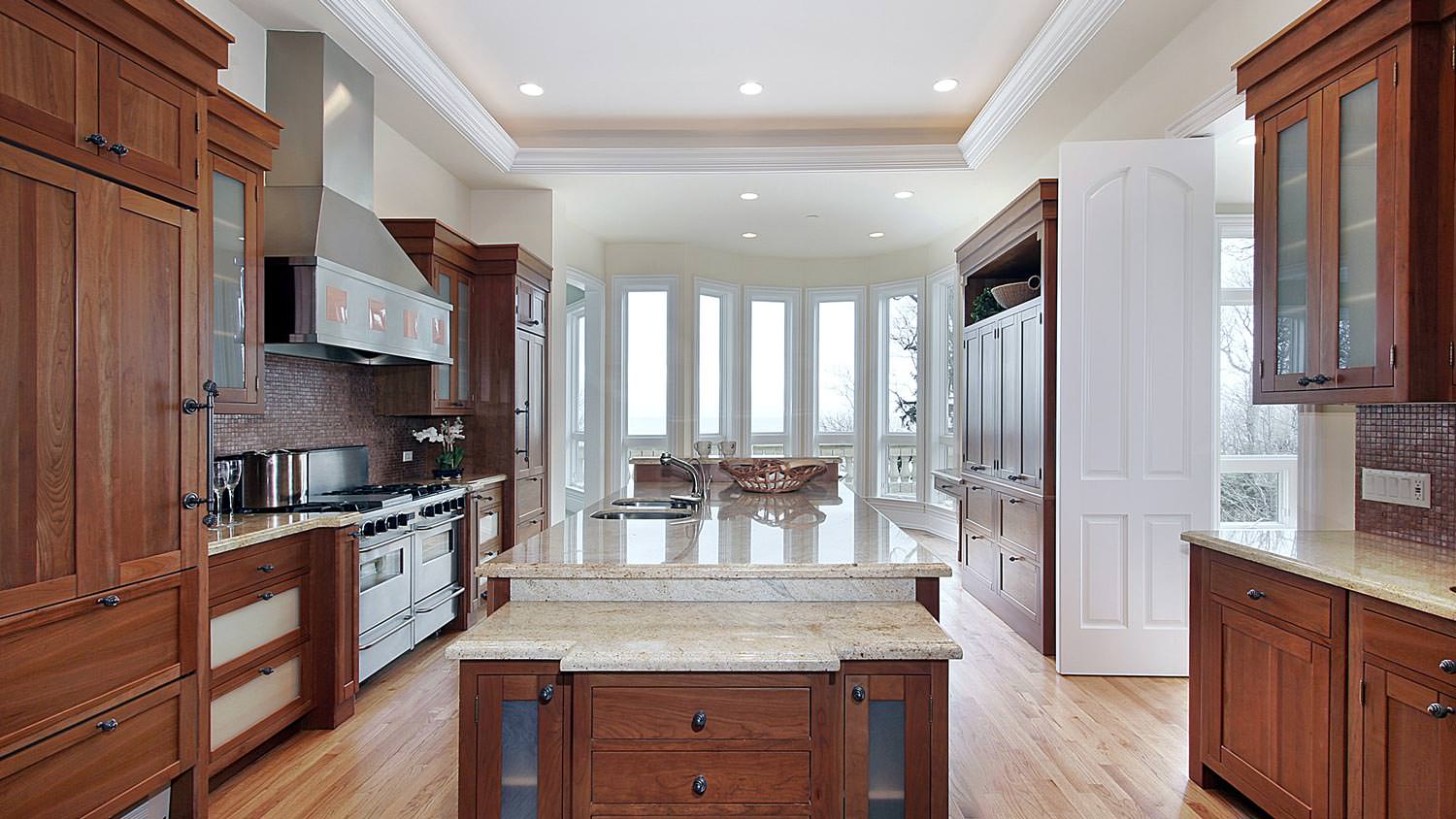
Get transparent light fixture repair cost info. Learn what impacts price, compare repair vs. replacement, and find ways to save.
Give your space a glow-up


Recessed lighting is installed directly inside the ceiling or wall.
You can choose from a variety of trims such as decorative, adjustable, and reflector.
Consider the style of your home when choosing the type of recessed lights.
If you’ve ever been to a lighting store, you know that choosing the right fixtures for your home can be a bit overwhelming. There are chandeliers, lamps, wall sconces, and so many others to pick from. But if you’re a “less is more” kind of person, recessed lighting might be for you. Dive into the modern and minimalist world of recessed lighting before you decide on your next light fixture upgrade.
Recessed lighting is a great way to discreetly brighten up any room. The lights are installed directly inside the ceiling, surface, or wall and are made up of three components: the housing, the trim, and the bulb style.
The housing is the light fixture itself and is kept hidden, while the trim is the decorative, visible part of the fixture. The final part is the bulb, which is what produces the light.
While recessed lighting is a great solution for homes with lower ceilings, there are many other things to consider if you’re thinking about installing them. After all, lights greatly affect the mood and style of your space.
Room layout: Take into account the size of the space, the amount of lighting you’ll need, and whether the ceiling will be the only source of light in the room.
Ceiling height: The higher the ceiling, the more lights you need. If your ceiling is low, you’ll need to space your lights closer together.
Total cost: Recessed lighting costs between $100 to $500 per light fixture, and $300 on average. This depends on the number of lights, installation cost, and energy usage.
Style and mood: Is your home a modern, traditional, minimalistic, or industrial space? That will determine what kind of recessed lighting works best for your aesthetic.
Structure: Before you start any lighting project, check the area for any obstructions such as air ducts or pipes.
Before hiring a pro to install your lights, figure out if recessed lighting is right for you. Here are some specific advantages and disadvantages of recessed lighting:
The light fixture isn’t visible, creating a beautiful, minimalistic, and sleek look
They can make a room look bigger because there are no fixtures hanging from the ceiling
It’s the only type of light that can be placed in water-focused environments, like bathrooms
They can spotlight art pieces or reading nooks
They have the ability to light up an entire room no matter how big or small it is
Perfect for hallways, kitchens, bathrooms, shower stalls, theaters, and basements
While they do light up an entire room, you’ll need more of them to do it
They are more difficult to install
They can create moisture and mold problems if water gets into the ceiling spaces
They are not usually adjustable; while there are adjustable options, those can get pricey
Not suitable for larger rooms or spaces with vaulted ceilings

There are a few different types of recessed lighting fixtures you can choose from, based on their functionality.
When it comes to recessed lighting, you have the option between can or canless fixtures. A can light features a cylindrical housing that contains the fixture’s socket, a protective shell, electrical hardware, and brackets or clamps. Installing a can light requires access to the ceiling, and is easier to install during the construction of a home rather than after it's already built.
A canless light features an all-in-one design that includes the housing, bulb, and trim. Installing canless lights is much easier than can fixtures, as you simply need to punch a hole in the plasterboard to install it. However, with its compact design, you’ll need to replace the entire fixture when the light burns out.
New construction fixtures go directly into the structural supports, making them ideal for unfinished walls or ceilings. Remodel recessed housings, however, have more of a secure fit since they slip into a small opening and have adjustable arms.
IC-rated (insulation contact) fixtures are designed to be installed in areas where insulation is present. They feature an air gap that keeps the outer can cool enough so it doesn’t present a fire hazard.
For non-insulated areas, non-IC housing is recommended. These fixtures are designed to not come in contact with insulation, as they present a fire hazard. High-wattage bulbs can be used with this style of housing to enhance the brightness of the space.
Low voltage systems typically run on 12-volt power. Low voltage is most useful when lighting a difficult-to-access area, such as a staircase.
Line voltage is the more standard type, running on 120 volts. It’s also typically more expensive, yet easier to install, and best for areas that require ambient light.
The visible part of the recessed lights is the trim. This is where you can get creative and choose the type of trim that complements your decor.
You can select trims that blend into the ceilings or go for a bolder approach. You can also decide on whether you want your recessed lights to be stationary or adjustable. Here are some of the common trims that can make a huge difference in your room:
Baffle trims: The most common trims used in residential homes. They have a grooved texture that creates a softer and more diffused light, making them ideal for bedrooms or living rooms.
Decorative trims: This trim adds a lot of personality to your room. They come in a variety of colors, sizes, and shapes that allow for more creativity in your design.
Surface adjustable trims: These give you the option of pointing the lights where you need them and focusing on a specific section of the room. They are perfect for highlighting your favorite piece of art!
Reflector trims: This trim is smooth and polished. They provide the maximum amount of lighting and are best for high ceilings or commercial properties.
Wall wash trims: This type is great for smooth surfaces and provides uniform brightness. They’re ideal for hallways or narrow rooms, as they create the illusion of a bigger space.
Lensed trims (or shower trims): Ideal for bathrooms because they contain a plastic or glass cover that protects them from water.
Recessed lighting can provide illumination to any room in your home. However, there are some areas that it’s better suited for than others:
Kitchens: Adding recessed lighting to your kitchen helps brighten the space and illuminate certain tasks. Placing it over the island or countertops can provide task lighting for cutting, chopping, and cooking.
Living rooms: Recessed lights are ideal for illuminating your living room with ambient lighting. They can be used in living rooms with low ceilings as the main light source, or they can enhance the glow of a focus piece, such as a pendant light or chandelier. They can also be used to illuminate certain objects or photos.
Hallways and closets: They provide a line of illumination in these areas where hanging or large fixtures would get in the way.
Bedrooms: Adding recessed lights to your bedroom enhances the ambiance and can help create a warm, cozy vibe. Make sure to opt for warm light bulbs in this space to boost your melatonin production.
Installing recessed lighting requires advanced skills and electrical knowledge. If you have the tools to complete the installation yourself, you can save some extra cash in your wallet by doing so. A DIY installation will cost you between $100 to $500, depending on the fixtures you choose.
If you feel uneasy about tackling the job yourself, it’s best to contact a local light fixture technician. The cost of installation will range from $100 to $480 per fixture, but it's a worthwhile investment. They have the knowledge and techniques to get the job done safely and correctly. They’ll also be able to answer any questions you have, cut holes in the ceiling with no issue, complete the installation, and make sure everything works correctly.
Haley Nothstein contributed to this piece.
From average costs to expert advice, get all the answers you need to get your job done.

Get transparent light fixture repair cost info. Learn what impacts price, compare repair vs. replacement, and find ways to save.

Discover the average wall sconce installation cost, key price factors, and ways to save on your lighting project. Get transparent, expert-backed cost info.

Light fixtures are important elements in any home. Find out how much it costs to install a light fixture based on factors like type, location, and labor.

If you’re planning to install recessed lighting, one of the first things you’ll do is figure out how many recessed lights you need. Here’s how to do that.

Make sure you practice safety first when DIYing your shower light. Use this guide to learn how to remove a shower light cover effectively.

Installing recessed lighting can be a difficult task, so it’s important to hire the right professional to do the job.